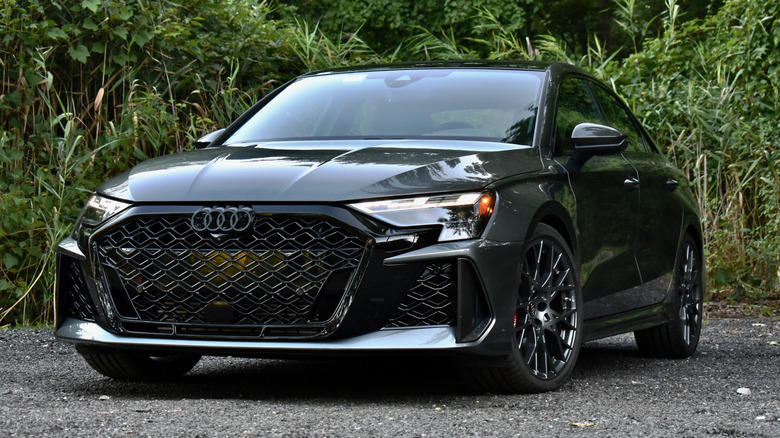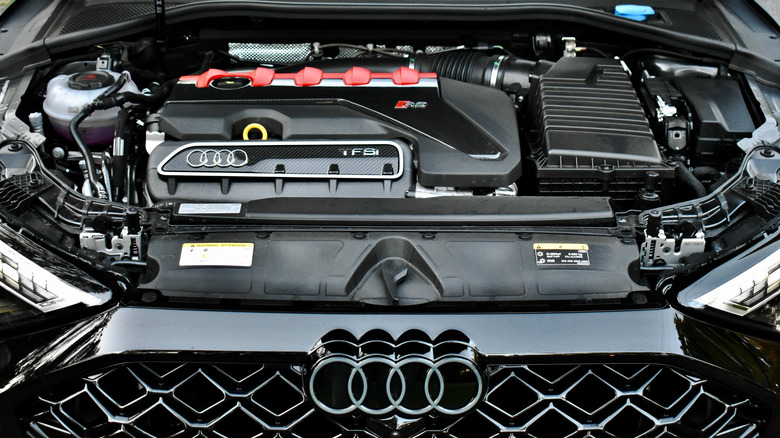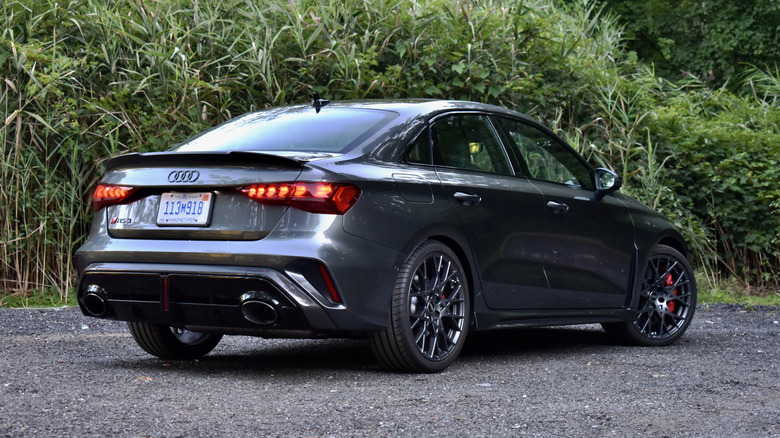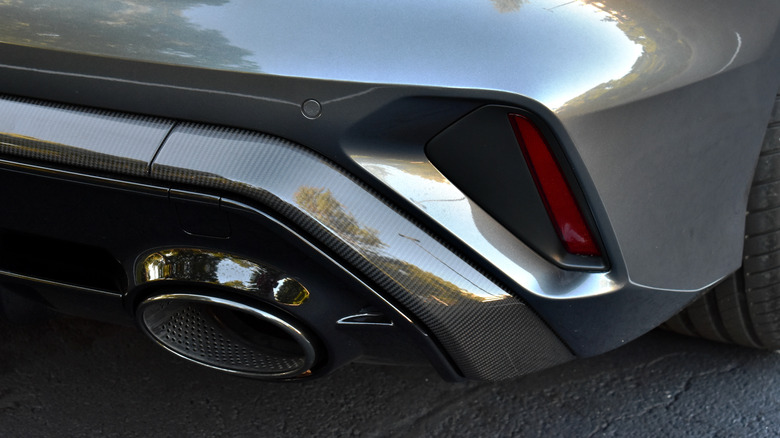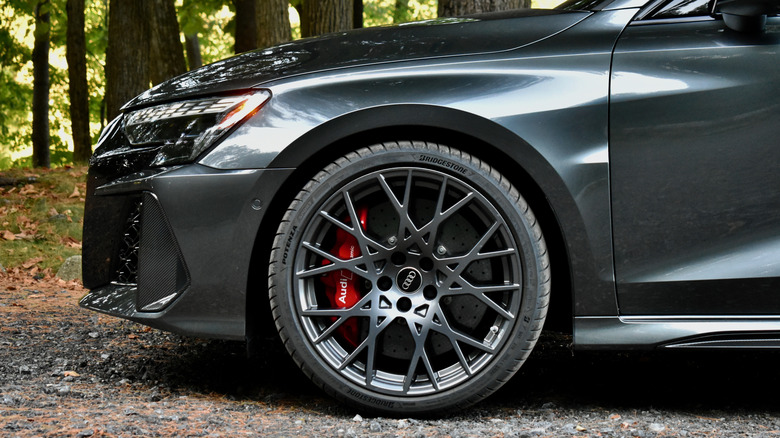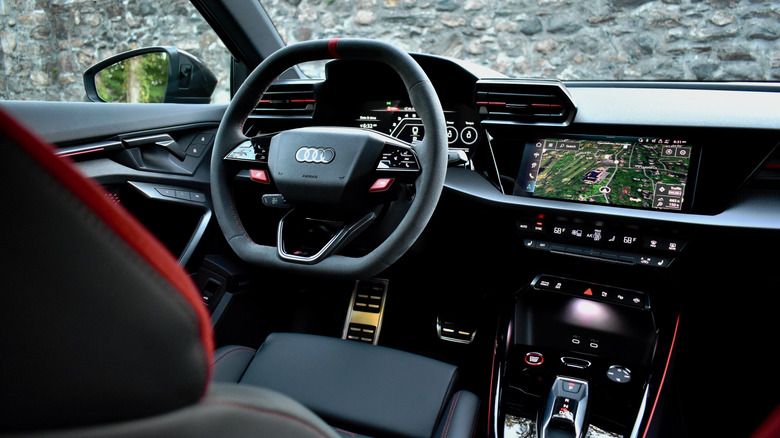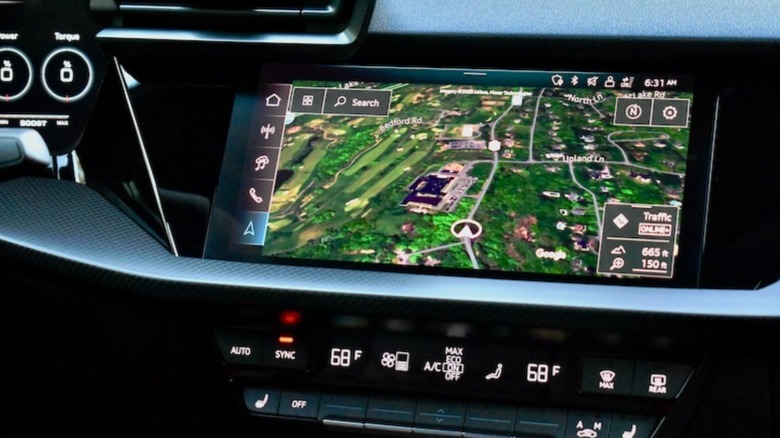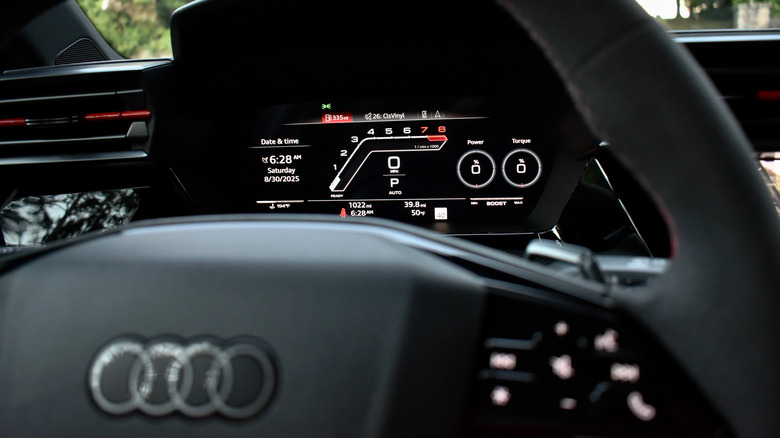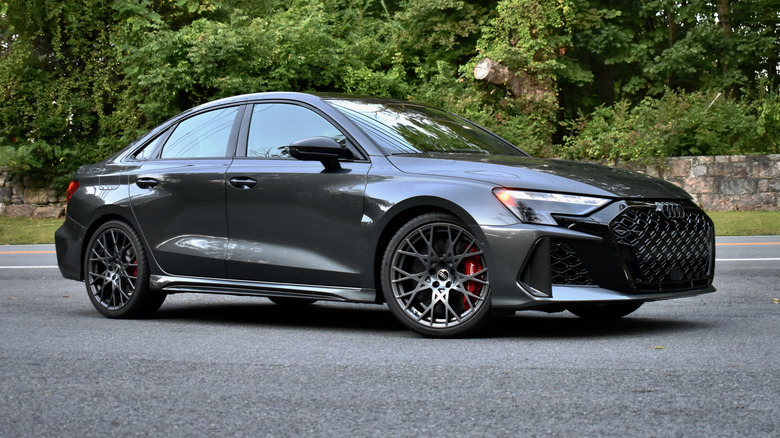The 2025 RS3 Is Proof Audi Isn't Boring
The discourse may remain firmly fixed on EVs, and the market on SUVs, but shoppers looking for a traditional gasoline sport compact are spoiled for choice. From familiar names like the Subaru WRX and Volkswagen Golf GTI, to more recent arrivals like the Hyundai Elantra N and Toyota GR Corolla, there's plenty to pick from. And for those who want more of everything, there's the 2025 Audi RS3.
Audi first applied an RS badge to its compact A3 in 2015 for the European market, with U.S. sales following in 2017. The second and current generation arrived in 2022, with some revisions for 2025. Audi recalibrated the various chassis control systems to make it easier to access the RS3's deep well of capability, and made the exterior look even more imposing, but kept the distinctive engine and maintained an overall high level of refinement.
The result is a compact four-door sedan that can be as rambunctious as its less-pricey brethren, but still feels like an Audi when you need it to, while also celebrating the brand's long motorsports history. It's a car that enthusiasts will appreciate, but that anyone can respect.
Race car looks
The Audi A3 on which the RS3 is based has gotten uglier over the years as Audi, seemingly running out of new ways to refresh its signature design language, has simply piled on styling details that visually weigh down the once trim-looking sedan. But the RS3 makes that work to its advantage.
This performance model has even more visual clutter, from flared fenders to a front end that doesn't seem to have enough room for both the large grille and the air intakes that flank it. The latter get bigger and more angular for 2025, while a revised rear diffuser breaks free of the rear bumper, while sporting a pair of incongruous round exhaust finishers. If that doesn't grab enough attention, you can also have many of these pieces, as well as the mirror caps and rear spoiler, finished in carbon fiber.
The result still isn't pretty, but it is kinda cute, giving the impression of a small dog desperately trying to look intimidating. And it visually links the road car to the RS3 LMS race cars that are a common sight on grids around the world. The popularity of the racers gives the RS3 a genuine motorsports pedigree unlike any current Audi model, carrying on a tradition going back to the legendary Coupe Quattro.
A very special engine
A racing resume isn't the only thing the RS3 has in common with the original Audi Quattro—it also has a five-cylinder engine. This unusual configuration was introduced in the 1976 Audi 100 after engineers, looking to increase displacement and unable to enlarge an existing four-cylinder engine, ruled out an inline-six because it would have been too long. It became a fixture in the brand's standard sedans, while turbocharged versions were used in the Quattro and the first RS model—the RS2 wagon—but today the RS3 is the only Audi with this engine.
Today's turbocharged 2.5-liter fiver develops 394 horsepower and 369 pound-feet of torque, and is connected to a seven-speed dual-clutch transmission with all-wheel drive. Its zero to 60 mph time of 3.6 seconds is 0.1 second quicker than that of a BMW M2 CS, and it can reach 180 mph with the optional Dynamic Plus Package (155 mph otherwise).
A turbo-four engine could probably do a similar job, quite frankly, but the five just feels special. It has a distinctive sound—a mechanical whir like an angry espresso machine—that you literally will not find in any other new car. It's also nice that Audi gave the RS3 a bespoke engine, rather than just turning up the boost on the engine from the already-quick S3. And it's hard not to feel the romantic sense of history when you're running the five up to its redline and imagining your favorite backroad as a rally stage.
Chassis smarts
An engine isn't the only thing that makes the RS3 special, though. Audi packed in chassis tech normally reserved for the more senior German sports sedans. The RS Torque Splitter uses individual multi-disc clutches for each rear driveshaft to vary the power split between the rear wheels, depending on longitudinal and lateral acceleration, yaw and steering angles, throttle positions, and the current gear and drive mode. This helps cancel out understeer and makes the RS3 corner more sharply.
The RS3 also features a more conventional brake-based torque-vectoring system to aid the all-wheel drive system in distributing power in accordance with grip, as well as adaptive damping. With the 2025 update, all of these features work more closely together with the electronic stability control thanks to new software for the car's central vehicle dynamics controller. According to Audi, a key benefit is the ability to turn in earlier, with less steering angle, and thus be better positioned to accelerate out of the corner earlier.
To prove this, Audi sent the updated RS3 back to Germany's Nürburgring Nordschleife in 2024, where it beat the previous car's time by 7.6 seconds, providing empirical proof that the changes really are improvements and not just something for padding out press releases. Achieved on optional summer tires, the 7:33.123 lap time over the 12.9-mile Nordschleife also beat the previous record for compact cars by more than five seconds, Audi claims.
Capable and engaging
Even if you're not a professional driver, the RS3 will help you get the most out of it. The chassis-control tech functions in a seamless but also engaging way; providing encouragement rather than just covering up mistakes. The RS3's small size helps, as it's not flinging as much weight around. That daintier quality combines with the well-tuned torque-split systems to help the RS3 change directions eagerly, but not in a way that feels artificial.
In the sportier drive modes, adaptive damping puts compliance into the ride for all but the most battle-scarred roads, maintaining grip without the constant bouncing over road imperfections that results from overly-stiff suspension. The RS3 corners as flat as one would expect of a Nürburgring record holder, contributing to the otherworldly feel of its chassis. The squared-off steering wheel has the hefty weight that German automakers love in their performance cars, but it's still delicate and communicative enough that smoothly aiming the RS3 toward corner entry is easy and enjoyable.
The RS3 is yet another example of how technology can make performance cars more accessible to drivers of varying skill levels. But while the flipside of this is often a detached feeling, like the car is doing all the work, that's not the case here. Driving it feels like having superpowers, like the boundaries of possibility have just been expanded.
Refined enough for the real world
Cars built for fun still have to function in the real world, and the RS3 checks that box as well. It's able to pull its rambunctious side back enough to make the more tedious types of driving tolerable for both you and anyone who might come along for the ride.
That's partly thanks to a selection of drive modes that, unlike in many other cars, have genuine differentiation. These include Efficiency, Comfort, Auto, and Dynamic modes similar to other Audi models, plus RS Performance and RS Individual modes accessible via the checker flag and "RS" buttons on the steering wheel, respectively. RS Performance mode is the factory setup for maximum sportiness, while RS Individual lets you mix and match individual settings.
The default Auto mode dials back the sound and the ferocity of the shifts from the dual-clutch gearbox enough so that you won't feel worn out after a long highway slog, without completely anesthetizing things. Comfort dials in a little extra suspension cushioning to passengers' benefit, while Dynamic wakes the car up a bit more without leaving the engine straining at near redline.
Credit also goes to the solidity of the Volkswagen Group MQB platform that underpins the RS3, as well as its working-class Volkswagen Golf GTI and Golf R cousins. It makes the VW models feel like a step above their economy-car roots, rather than the other way around, making the Audi a true junior version of the automaker's pricier fare.
An interior with personality
Adding to the premium feel is a distinctive interior that builds on the base Audi A3's angular theme. Details like trim pieces that streak across the doors and into origami-like handles, and air vents alternately sunk into the dashboard and propped up around the digital instrument cluster are complemented by rhombus-shaped laser cutouts in the door panels that are backlit as part of a standard ambient lighting system. A squared-off steering wheel is new for 2025 and blends in with the sharp angles of the dashboard nicely. Less impressive is the toggle-operating shifter, which doesn't stand out like the other interior elements and is also placed right in the middle of the center console, eliminating any space-saving benefit from the compact mechanism.
As expected in a sports sedan, heavily-bolstered front seats are standard. Generous cushioning makes them suitable for the road as well as the track. The predictable Alcantara trim is included as well, along with, in this test car, Express Red contrast stitching and trim. That's part of the optional Design Package, and seems like a good choice to liven up the otherwise-black interior. A less-traditional Micrommata Green option is also available.
Audi didn't provide any infotainment updates for 2025, but the 12.3-inch digital instrument cluster and 10.1-inch touchscreen are easy to navigate and feature gorgeous graphics, including Google Maps satellite views and a hockey-stick tachometer with a retro 1980s vibe.
Practical enough
It may be a small car, but the RS3 is still a four-door sedan with usable rear seats, giving it an advantage over the similarly-priced BMW M2 coupe. It also has similar rear-seat headroom and legroom to the four-door BMW M235 xDrive Gran Coupe (which isn't available in full-fat M2 form), although taller drivers might find the front seats a bit more cramped.
It's a similar story with the outgoing second-generation Mercedes-Benz CLA-Class, which is being replaced with a new generation that won't have an equivalent to the current AMG CLA45 performance model, at least not right away. However, both the BMW and Mercedes compact four-doors have more trunk space than the RS3's 8.3 cubic feet.
The Audi is still a more practical choice than dedicated sports cars, and considering the amount of power its turbo-five engine develops, even offers reasonable EPA fuel economy of 23 mpg combined. Matching that in the real world will be difficult, though, as fuel consumption increases steeply in the sportier driving modes. A 35-mile sprint along a favorite driving road erased 100 miles of indicated range.
2025 Audi RS3 verdict
With its touring-car styling, practical sedan body style, and multitalented chassis, the 2025 Audi RS3 offers a lot of car for your money. That's good, because you'll also be paying a lot to get one. Pricing starts at $67,395 but fully-optioned versions cost $78,140. That's rarefied air for what is, after all, a souped-up version of Audi's entry-level model.
There's nothing quite like the RS3, though. As noted above, the BMW M2 is the Audi's peer in performance and price, but it's only available with two doors. The Mercedes-AMG CLA45 S offers a similar combination of high performance and compact four-door practicality, but it's not long for this world. Mercedes is only keeping it around for one more model year as a new, electric-first CLA-Class arrives.
It's also possible to get lots of fun out of a similar compact-car package for less money. Cars like the Volkswagen Golf R and Acura Integra Type S (notable for its manual transmission), or even the middle-child Audi S3, aren't as sophisticated as the RS3, but are perhaps better values when it comes to the amount of enjoyment per dollar. But anyone who test drives an RS3 will be looking for a way to make the numbers work.
